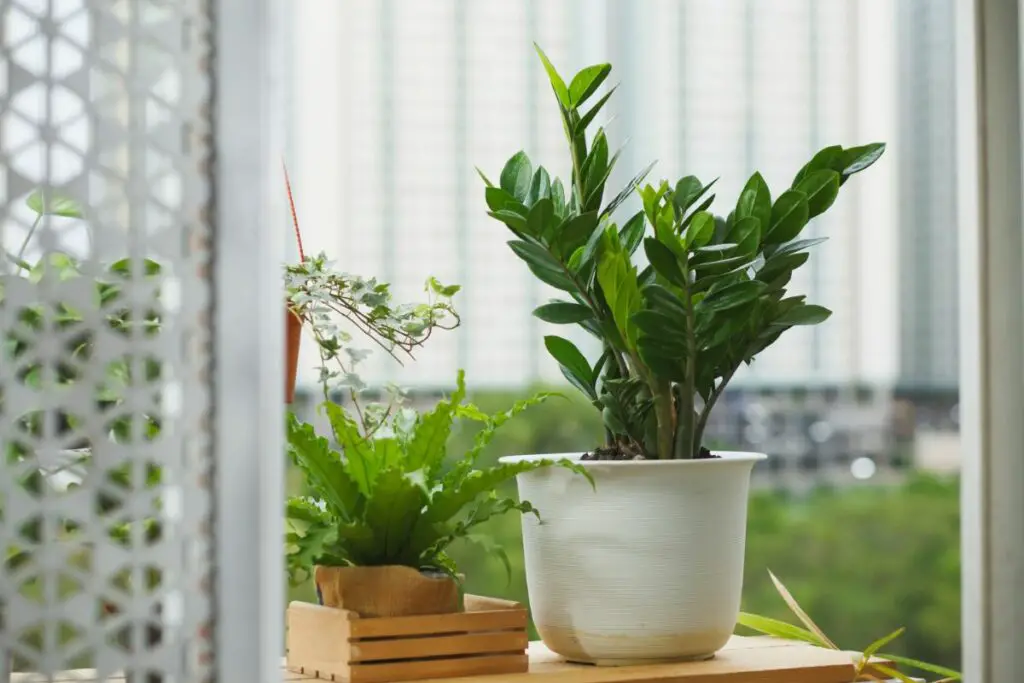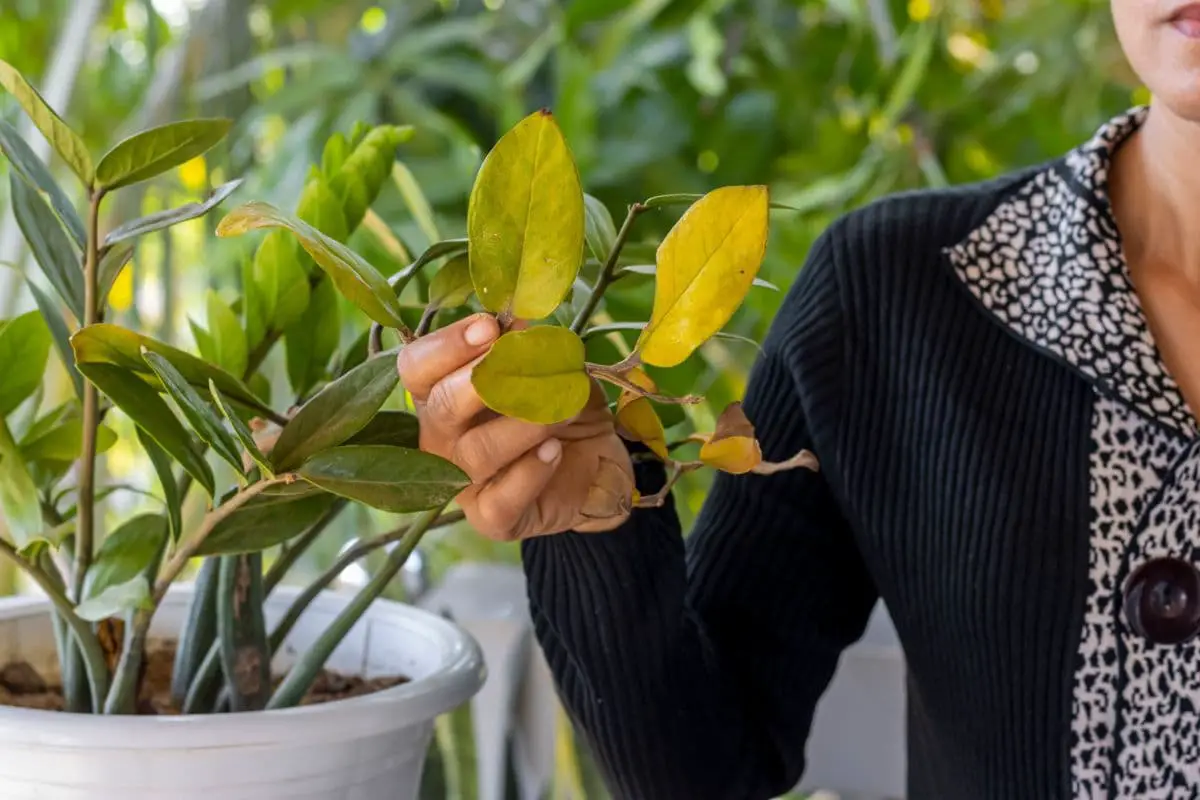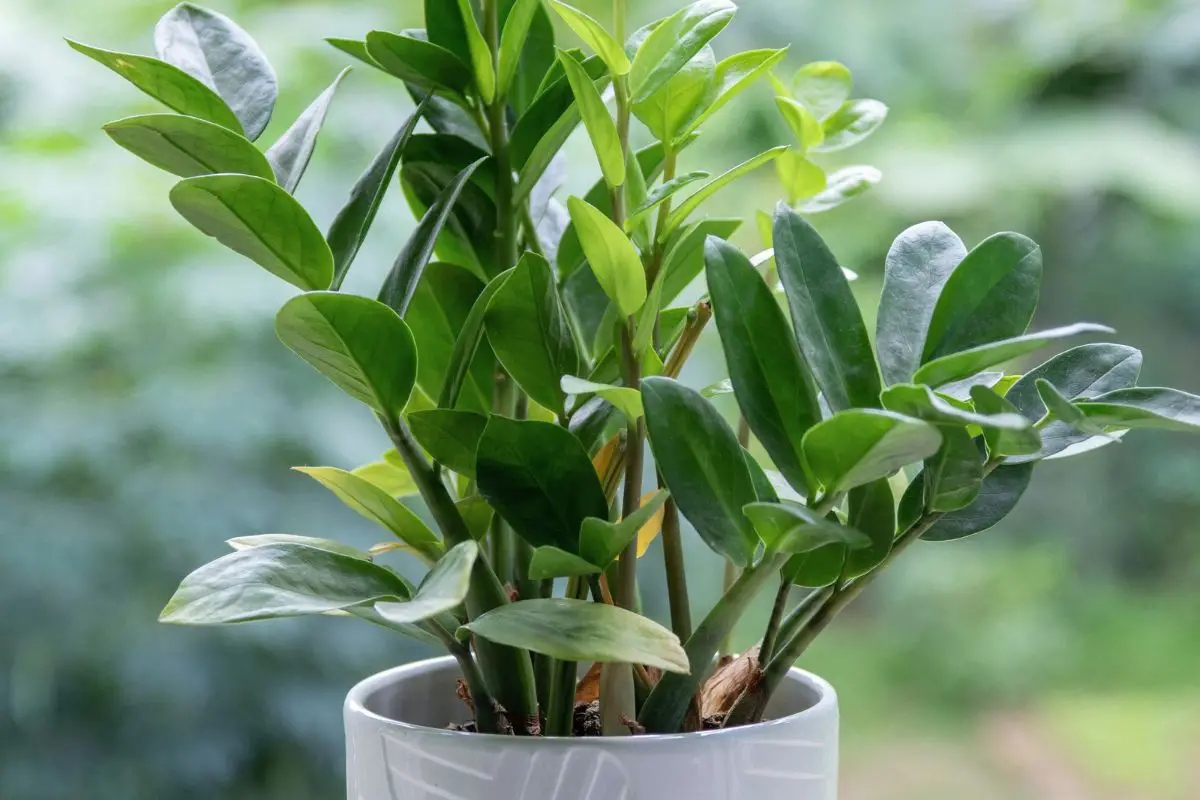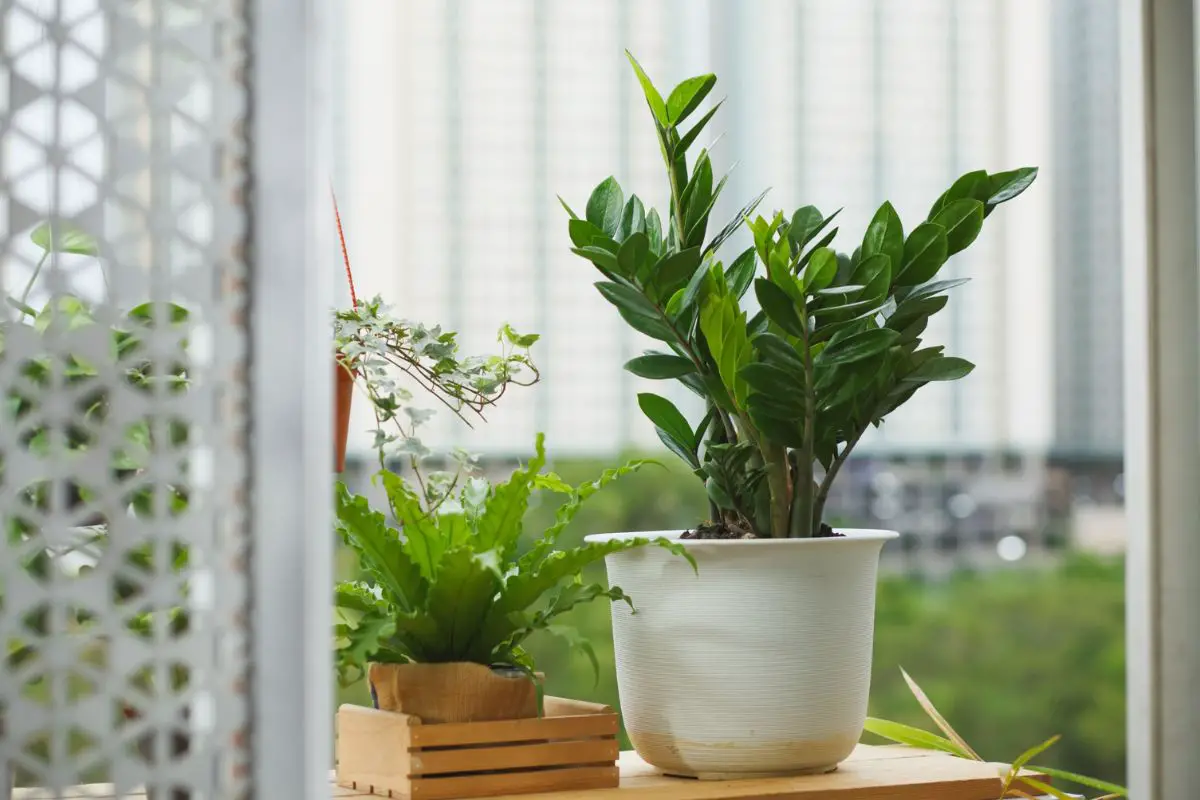ZZ plants (Zamioculcas zamiifolia) are famous for their drought tolerance. However, unlike true succulents and cacti, they’re not very tolerant to heat and intense sunlight. As tropical natives, they’re not very cold-tolerant either.
ZZ plants thrive in moderate temperatures ranging from 65-85 °F (18-29 °C). They can tolerate up to 90 °F (32 °C) when well-watered and out of direct sunlight. On the other hand, they grow more slowly at temperatures around 60 °F (15.6 °C) and will stop growing altogether below 50 °F (10 °C).
Temperature plays a vital role in the growth, health, and appearance of ZZ plants. This article will discuss everything you need to know to provide your plant with the best indoor environment.

ZZ Plants: An Overview
ZZ plants are native to the tropical regions of East and South Africa, which have only wet and dry seasons. As a result, they’re accustomed to moderate temperatures all year round.
The region’s temperature seldom dips below 50 °F (10 °C), so ZZ plants are not cold tolerant. Frosts can damage or kill them, so it’s best to keep them in regulated temperatures indoors if you live in colder climates with fall or winter frosts.
Although temperatures may occasionally rise over 90 °F (32 °C), the canopy of trees or taller shrubs provides shelter from the intense sunlight. ZZ plants also retain moisture in their fleshy roots, stems, and rhizomes, so they don’t easily get dehydrated despite occasional temperature spikes.
However, some years have extreme temperatures with scarce rains, low humidity, and intense sunlight.
Such conditions can dry out the leaves and cause them to:
That said, environmental temperatures significantly affect a ZZ plant’s health. They can also influence your plant’s chances of flowering.
The flowers aren’t showy or remarkable, but their appearance indicates how well you care for your ZZ plant, which is often linked to good fortune in Asian culture.
Temperature Requirements
Here’s a guide to help you better understand your ZZ plant’s temperature requirements:
Ideal Temperature Range
ZZ plants have slightly different temperature requirements at various life stages.
Leaf or Stem Cuttings
Cuttings root faster when kept between 85 and 90 °F (29 and 32 °C) for 3-6 months. The constantly moist substrate and bright indirect light help relieve potential stress from high temperatures.
At lower temperatures, the cuttings may root more slowly. On the other hand, above 90 °F (32 °C) can cause heat stress and dry out the young plants faster.
Mature Plant
As the plant becomes more established, it requires less frequent watering and lower temperatures. At this point, it prefers between 65 and 85 °F (18 and 29 °C).
Higher temperatures can promote rapid moisture loss and potentially dehydrate your plant, especially in brighter light conditions and infrequent watering.
On the other hand, temperatures below 50 °F (10 °C) can significantly slow down metabolic activities and your plant will appear to have stunted growth.
Frost or freezing temperatures can freeze the moisture stored in the stems and cause structural damage once they thaw. Due to the damage, you may be left with weak or limp stems.

How Temperature Affects Flowering
Mature ZZ plants can handle a wide range of temperatures. However, you’ll have better chances of seeing their flowers by maintaining them close to 75 °F (24 °C). In their native habitat, the flowers typically come out toward the end of the wet season.
In my case, they bloom around summer to early fall when they receive stable temperatures throughout spring.
Pro tip: ZZ flowers may bloom a few times a year starting in early spring if you maintain warm temperatures and optimal light, humidity, and watering conditions, even in fall and winter.
However, your plant might not bloom every year if it doesn’t get a few months of slower metabolic activity—ideally in mid-fall to winter.
To encourage your plant to bloom annually, reduce the watering frequency during the cold season to mimic the dry season in their native habitat. You can also drop the temperature below 70 °F (21 °C).
My 10-year-old ZZ plant has been producing 1-3 blooms year after year since it was 5 years old. The sweet spot is around 75 °F (24 °C) in spring and summer and 60-65 °F (15.6-18 °C) in fall and winter.
Measuring Temperature
You can measure and maintain optimal temperatures using a thermostat. Choose one with a hygrometer to also monitor and regulate the humidity (40-60%) around mature plants.
Remember that the thermostat’s reading doesn’t indicate the same temperature throughout the house if you have a large space.
Here are the tips to measure the temperature around your plant accurately:
- Check the reading on the thermostat.
- Use a room thermometer to measure the temperature in the area where your ZZ plant sits.
- Take note of the difference. For instance, the thermostat may read 70 °F (21 °C, but the plant area across the room may show a few degrees higher or lower depending on the season, the distance from the windows, the surrounding appliances, or the location of the air conditioner or heating vents.
You can then adjust the temperature around your plant using a heating mat when rooting cuttings or a space heater near your indoor garden during the cold season.
Signs of Inadequate Temperature
It’s important to catch the signs early because the physical damage caused by extended exposure to inadequate temperatures is often irreversible.
Signs of heat stress include:
- Yellowing leaf tips
- Curling or wrinkling leaves
- Brown and crisp leaf tips
On the other hand, cold shock can cause the following symptoms:
- Paler leaves
- Yellowing leaves
- Limp stems
- Stunted growth
You can fix the problem in the early stages by:
- Adjusting the temperature in your home to optimal levels.
- Increasing the watering frequency if the high temperatures are drying out the soil and leaves more quickly.
- Hanging sheer curtains against bright windows.
- Moving your plant to a more comfortable spot if the original location receives fluctuating or extreme temperatures.
Optimizing Temperature
One of the primary reasons ZZ plants are popular houseplants is their low maintenance requirement. They can tolerate infrequent watering, low light, and a wide temperature range.
Optimizing a mature ZZ plant’s temperature conditions shouldn’t be burdensome because they thrive in a similar range that is comfortable to humans.
Proper Placement
Finding the right spot in your home garden is the key to ensuring trouble-free ZZ plant care.
Below are some important things to consider when choosing the proper placement:
Temperature Fluctuations
Avoid placing your ZZ plant next to windows or doorways. Sudden temperature fluctuations that exceed 10 °F any time during the day may stress your plant. Moreover, ZZ plants dislike direct sunlight.
Access to Light
Choose a spot that receives bright, indirect light. Maintaining the temperature around this area is easier if you don’t have to worry about the sun’s radiant heat.
Extreme Temperatures
Keep your plant away from areas with extreme temperatures, such as the direct path of cool air from AC units or warm air from heating vents. It also helps to keep them at a safe distance from appliances that heat up when in use, including artificial lights.
Adjusting to Seasonal Changes
Although outdoor temperatures naturally change along with the seasons, they don’t drastically affect indoor temperatures. You may only need to make a few adjustments in your indoor garden and ZZ plant care.
ZZ plants prefer cooler temperatures and less frequent watering in winter for slower growth and energy preservation.
Gradually drop the temperature in your thermostat by 2-3 °F per month starting in mid-fall until you reach the optimum low (60-65 °F or 15.6-18 °C), which you can maintain throughout winter.
Many houseplants also need this drop as they enter their dormant stage. A gradual increase in temperature and watering frequency can help them pick up their growth rate in spring.
Additional consideration must be given if you keep the windows open. The evening temperatures may drop too low and affect your ZZ plants.
Here are some tips for maintaining a suitable environment around your ZZ plant, even during cold nights or seasons.
- Place a heating mat below the pots when rooting cuttings. Maintaining the soil temperature at 80 °F (27 °C) at planting will reduce the rooting time by about a third. Conversely, fluctuating temperatures that occasionally dip below 70 °F (21 °C) can double the time it takes for the cuttings to develop enough roots and rhizomes.
- Use space heaters to regulate air temperatures. If you’re propagating ZZ cuttings during the cold season, space heaters are a convenient alternative to heating mats. Set the device to 90 °F (32 °C) and place the potted cuttings two feet (0.6 m) away.
- Set the space heater at 75-80 °F (24-27 °C) two feet (0.6 m) away from mature plants if night temperatures are expected to fall below 60 °F (15.6 °C).
Companion Plants
Several plants share similar temperature requirements with ZZ plants and will make a perfect addition to your indoor garden.
Here are some suggestions:
African Violets
African violets are flowering plants that also thrive in low-light areas, such as near a northern or northeastern window. However, they prefer moist air so you may need to keep the humidity at 60% to match both plants. Their purple or lavender flowers can provide a touch of color around your ZZ plant.
Chinese Evergreen
The colored or variegated foliage of Chinese evergreen is a stark contrast against the solid emerald of ZZ plants, adding interest to your garden.
Lucky Bamboo
If you believe in Feng Shui, you can place your ZZ plant and lucky bamboo in a southeast-facing spot in your home for good fortune and health. Be sure to keep them out of direct sunlight, maintain the humidity level at 50-60%, and water them regularly.
Monstera
If you want a jungle-like feel, I recommend adding monsteras next to your ZZ plants. Train them along a moss pole to keep them from taking up too much lateral space and stealing the spotlight from your humble ZZ plant.
Peace Lilies
The foliage of peace lilies have the same hue and height as ZZ plants. However, their white flowers that bloom even in low-light conditions can add interest against a deep-green background of foliage plants.

Outdoor Considerations
If you like placing your houseplants outdoors during the summer, remember that ZZ plants dislike direct sunlight.
Choose a shady spot in your garden, such as underneath a tree canopy or a porch, where the plants can receive filtered sunlight throughout the day.
Here are the tips for a stress-free transition for your plant:
- Acclimate your plant to the outdoor environment by gradually increasing the exposure by one hour a day for a week.
- Keep an eye on the soil moisture because you might need to increase the watering frequency due to brighter sunlight, higher temperatures, and winds.
- Look out for signs of stress, such as yellowing leaf tips, wrinkling, or drooping, which can indicate heat stress. You may need to water your plant more often or install a shade cover to filter the light.
Final Thoughts
ZZ plants are generally not finicky about indoor temperatures. However, home conditions can vary among plant owners, so it’s best to understand how to adjust your indoor garden for these plants to thrive.
Maintain your indoor temperatures within the optimal range of 65-85 °F (18-29 °C) and be proactive in inspecting your plant for signs of stress. You can do this every time you water your plant so you can diagnose and fix problems promptly.
Feel free to share some tips on optimizing your indoor temperatures for a thriving ZZ plant. If you have more questions about ZZ plant care or general gardening tips and tricks, don’t forget to leave a comment or subscribe.







